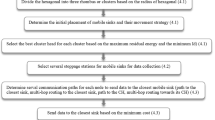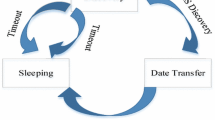Abstract
In the application of periodic data-gathering in sensor networks, sensor nodes located near the sink have to forward the data received from all other nodes to the sink, which depletes their energy very quickly. A moving scheme for the sink based on local residual energy was proposed. In the scheme, the sink periodically moves to a new location with the highest stay-value defined by the average residual energy and the number of neighbors. The scheme can balance energy consumption and prevent nodes around sink from draining their energy very quickly in the networks. The simulation results show that the scheme can prolong the network lifetime by 26%–65% compared with the earlier schemes where the sink is static or moves randomly.
Similar content being viewed by others
References
CALLAWAY E H. Wireless sensor networks: Architectures and protocols[M]. Boca Raton, FL: Auerbach Publications, 2003.
ZHOU Xuan, YU Shou-yi. Optimal sensor location for the parameter identification in the distributed parameter system [J]. Journal of Central South University of Technology: Natural Science, 2004, 35(1): 97–100. (in Chinese)
SOHRABI K, GAO J, AILAWADHI V. Protocols for self-organization of a wireless sensor network [J]. IEEE Personal Communications, 2000, 7(5): 16–27.
AI-KARAKI J N, KAMAL A E. Routing techniques in wireless sensor networks: A survey [J]. IEEE Wireless Communications, 2004, 11(6):6–28.
NICULESCU D. Communication paradigms for sensor networks [J]. IEEE Communications Magazine, 2005, 43(3): 116–122.
WANG W, SRINIVASAN V, CHAING K C. Using mobile relays to prolong the lifetime of wireless sensor networks [C]// Proceedings of the 11th Annual International Conference on Mobile Computing and Networking(MobiCom’05). New York, NY, USA: ACM Press, 2005: 270–283.
WANG G L, CAO G H, PORTA T L. Sensor relocation in mobile sensor networks [C]// Proceedings of the 24th Annual Conference of the IEEE Computer and Communications Societies (INFOCOM’05). Piscataway, NJ, USA: IEEE Press, 2005: 2302–2312.
LUO J, HUBAUX J P. Joint mobility and routing for lifetime elongation in wireless sensor networks [C]// Proceedings of the 24th Annual Conference of the IEEE Computer and Communications Societies (INFOCOM’05). Piscataway, NJ, USA: IEEE Press, 2005: 1735–1746.
SHAH R C, ROY S, JAIN S, BRUNETTE W. Data MULEs: Modeling a three-tier architecture for sparse sensor networks [C]// Proceedings of the 1st IEEE International Workshop on Sensor Network Protocols and Applications (SNPA’03). Piscataway, NJ, USA: IEEE Press, 2003: 30–41.
TONG L, ZHAO Q, ADIREDDY S. Sensor networks with mobile agents [C]// Proceedings of IEEE Military Communications Conference (MILCOM’03). Piscataway, NJ, USA: IEEE Press, 2003: 688–693.
JAIN S, SHAH R C, BORRIELLO G. Exploiting mobility for energy efficient data collection in sensor networks [J]. Mobile Networks and Applications, 2006, 11(3): 327–339.
GANDHAM S R, DAWANDE M, PRAKASH R. Energy efficient schemes for wireless sensor networks with multiple mobile base stations [C]// Proceedings of the IEEE Global Telecommunications Conference (GLOBECOM’03). Piscataway, NJ, USA: IEEE Press, 2003: 377–381.
AKKAYA K, YOUNIS M, BANGAD M. Sink repositioning for enhanced performance in wireless sensor networks [J]. Computer Networks, 2005, 49(4): 512–534.
VINCZE Z, VASS D, VIDA R, VIDACS A, TELCS A. Adaptive sink mobility in event-driven multi-hop wireless sensor networks [C]// Proceedings of the 1st International Conference on Integrated Internet Ad Hoc and Sensor Networks (InterSense’06). New York: ACM Press, 2006: 13–22.
BI Yan-zhong, SUN Li-min, MA Jian, LI Na, KHAN I A, CHEN Can-feng. HUMS: An autonomous moving strategy for mobile sinks in data-gathering sensor networks [J]. EURASIP Journal on Wireless Communications and Networking, 2007, 2007: 64574.
Author information
Authors and Affiliations
Corresponding author
Additional information
Foundation item: Project(60673164) supported by the National Natural Science Foundation of China; Project(20060533057) supported by the Specialized Research Foundation for the Doctoral Program of Higher Education of China
Rights and permissions
About this article
Cite this article
Tan, Cg., Xu, K., Wang, Jx. et al. A sink moving scheme based on local residual energy of nodes in wireless sensor networks. J. Cent. South Univ. Technol. 16, 265–268 (2009). https://doi.org/10.1007/s11771-009-0045-z
Received:
Accepted:
Published:
Issue Date:
DOI: https://doi.org/10.1007/s11771-009-0045-z




